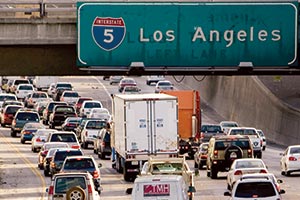California Moves Ahead With Its Own GHG Rule

This story appears in the Feb. 13 print edition of Transport Topics.
California is proceeding with its Phase 2 greenhouse-gas emissions rule for trucks — designed to be “harmonized” with the similar fed-eral rule released last year — no matter the fate of the U.S. regulation.
State officials said that the policy is one other states can adopt.
During a daylong workshop in Sacramento on Feb. 6, California Air Resources Board staffers offered a briefing on the state’s coming actions and projected a final rule by August, a comment period for September and a ratification vote by CARB members in October.
Truck makers often have urged uniformity among federal and state regulations, arguing that meeting multiple standards across the nation makes manufacturing difficult.
“We’re setting up regulations to help us achieve our goals, and we have harmonized with EPA and NHTSA as much as possible,” CARB spokesman David Clegern said in an interview after the workshop, referring to the U.S. Environmental Protection Agency and the National Highway Traffic Safety Administration, which combined to write the federal GHG rule.
Clegern said CARB members want the tighter GHG standards, in part because EPA has placed obligations on California to clean up its air, especially in the San Joaquin Valley and in metropolitan Los Angeles.
If federal Phase 2 is revoked, the CARB rule ensures California requirements will remain in place, according to the workshop presentation.
“No one knows what the fate of the U.S. Phase 2 rule will be,” said Mike Tunnell, director of energy and environmental affairs for American Trucking Associations. “But it is positive that the CARB and federal rules will be aligned.” Tunnell attended the workshop for ATA.
Phase 2 on carbon dioxide and other greenhouse gases was a major priority for the Obama administration, but the new Trump administration expressed a different view on environmental matters, in general, although it has not addressed Phase 2, specifically.
Phase 1 for trucks was rolled out in two stages, tightening GHG emissions first in January 2014 and then in January of this year. That EPA- NHTSA rule covered trucks and their engines, but not trailers.
A key part of the CARB rule, laid out in a PowerPoint document with 108 slides, is that original equipment manufacturers must submit their designs for vehicle or engine certification to EPA and CARB.
The federal and CARB rules call for tightening emission standards from trucks and their engines in 2021, 2024 and 2027.
It has been the case that vehicles and engines with federal certification were considered “deemed to comply” with California when the two standards matched. That will not be the case going forward.
Just as EPA has a federal emissions lab in Ann Arbor, Michigan, Clegern said CARB has a similar facility in El Monte near Los Angeles.
The first element of federal Phase 2 to take effect will be on trailers manufactured on or after Jan. 1, 2018. Considering that CARB does not anticipate formal adoption until October, that could place a squeeze on trailer makers, Tunnell said.
Clegern, however, said federal Phase 2 for 2018 — the first regulation of trailer makers by EPA — is similar to the way CARB regulates trailers in California, mainly by making the EPA SmartWay guidelines mandatory rather than voluntary, as they are in the rest of the nation.
SmartWay for trailers mainly advocates for aerodynamic attachments and low-rolling-resistance tires.
Tunnell said most of the other differences between the U.S. and CARB rules are subtle and could be ironed out in discussions.
“There are differences on labeling and credits,” he said, but not major differences on manufacturing standards.
CARB also is concerned about the “global warming potential” of refrigerants used by compressors in vehicle air conditioning systems and in truck refrigeration units.
CARB plans a second workshop on its GHG efforts in the spring.




